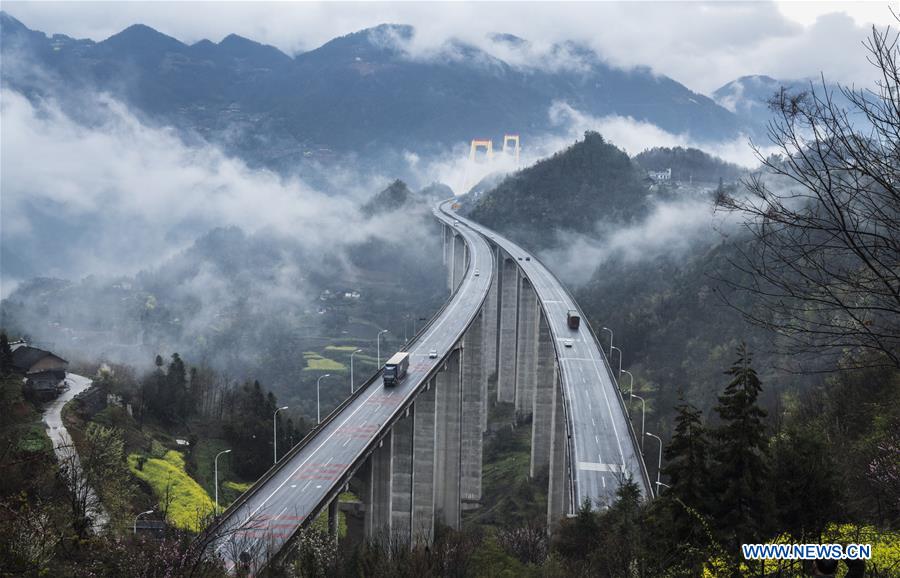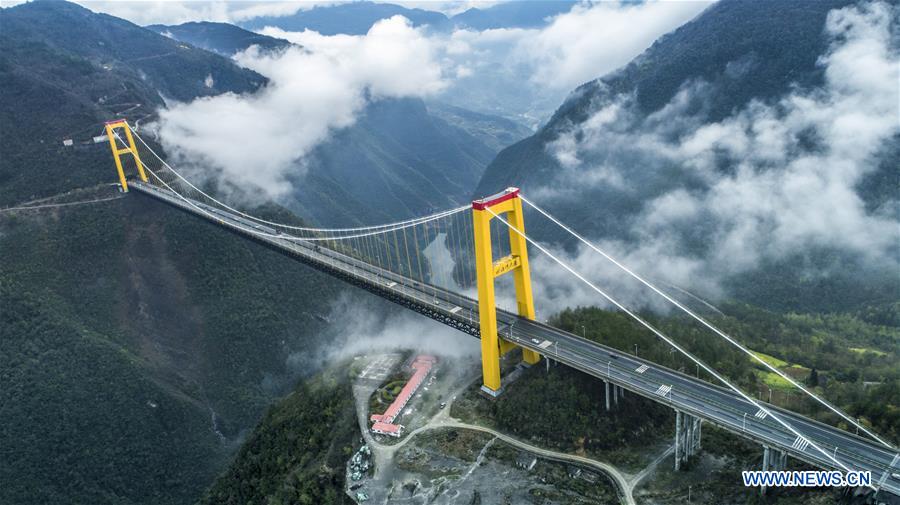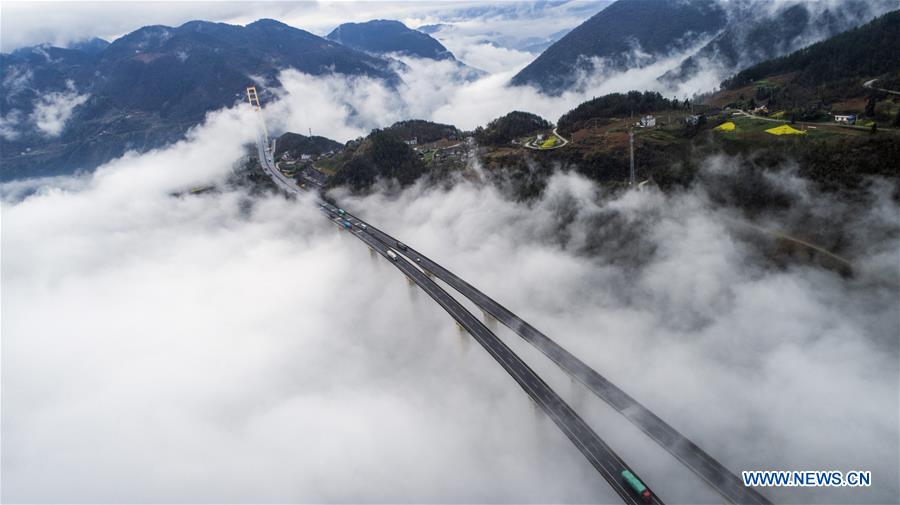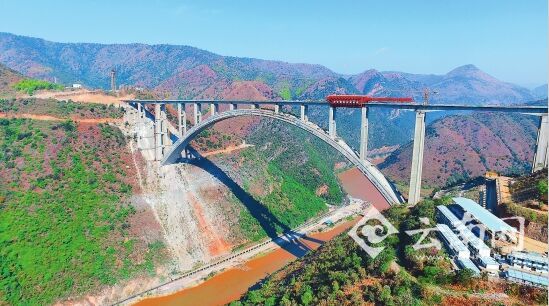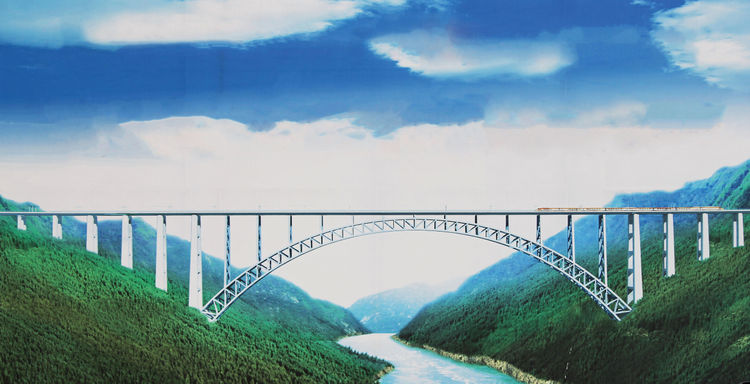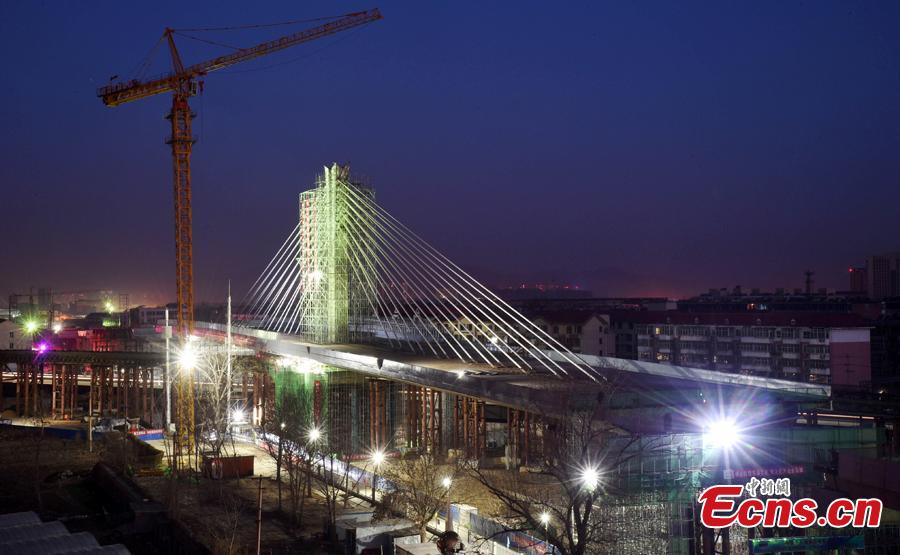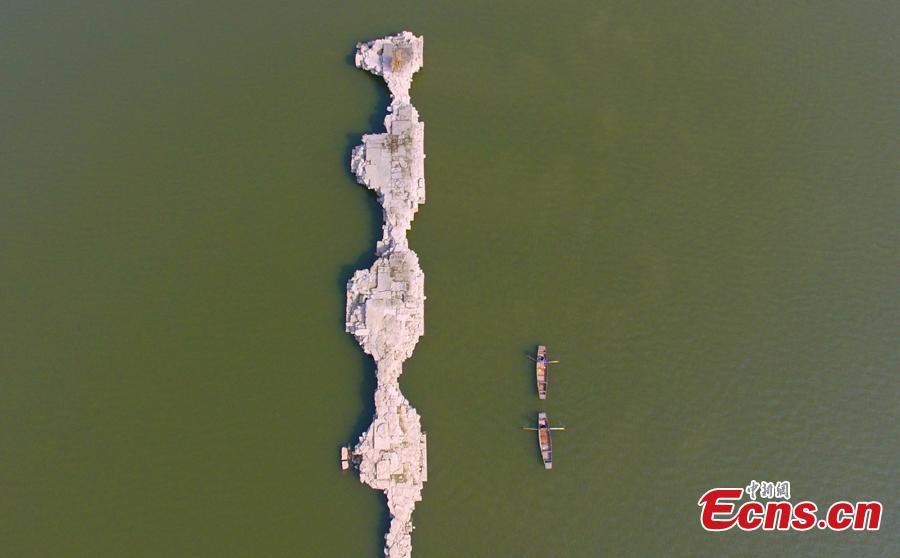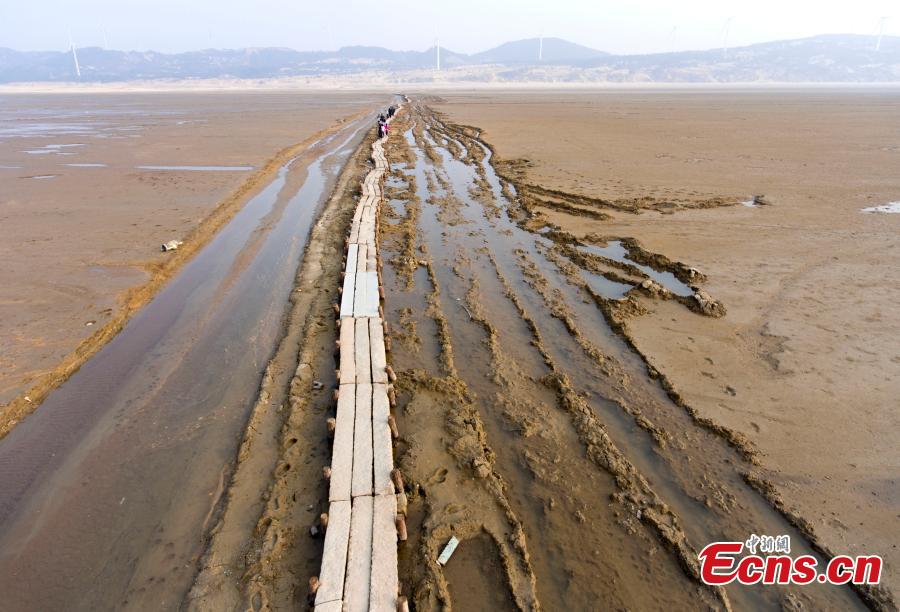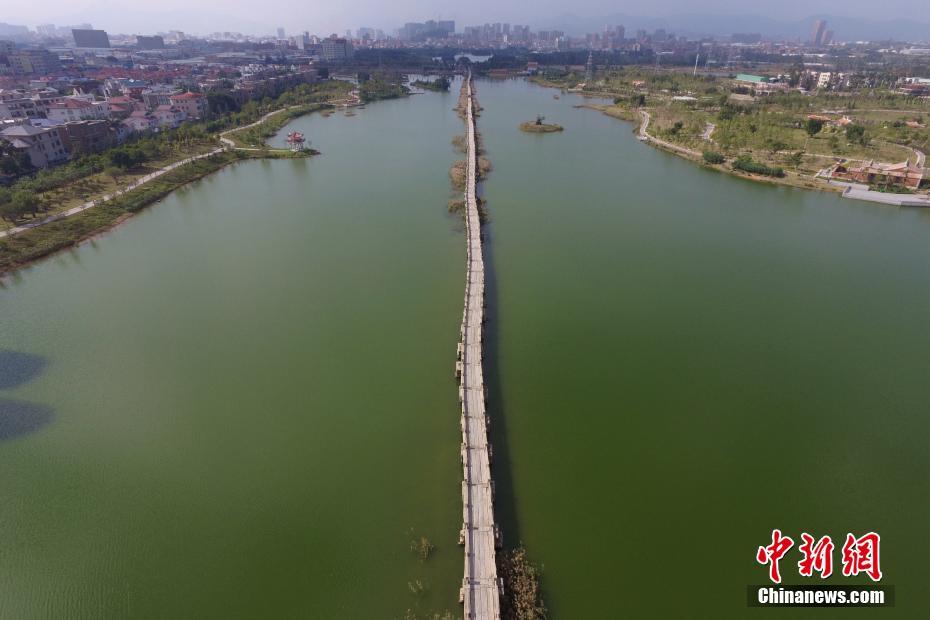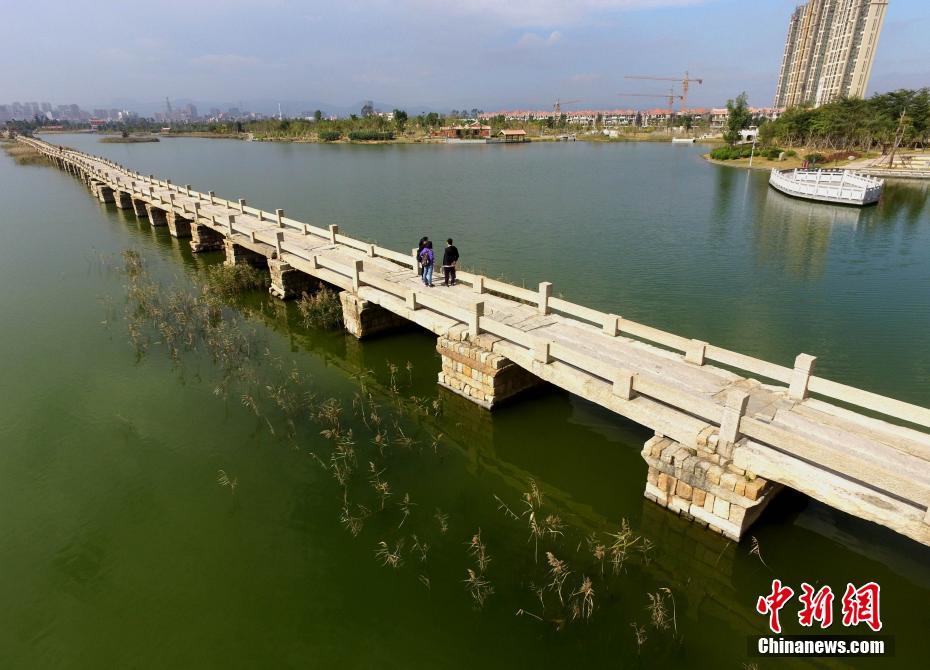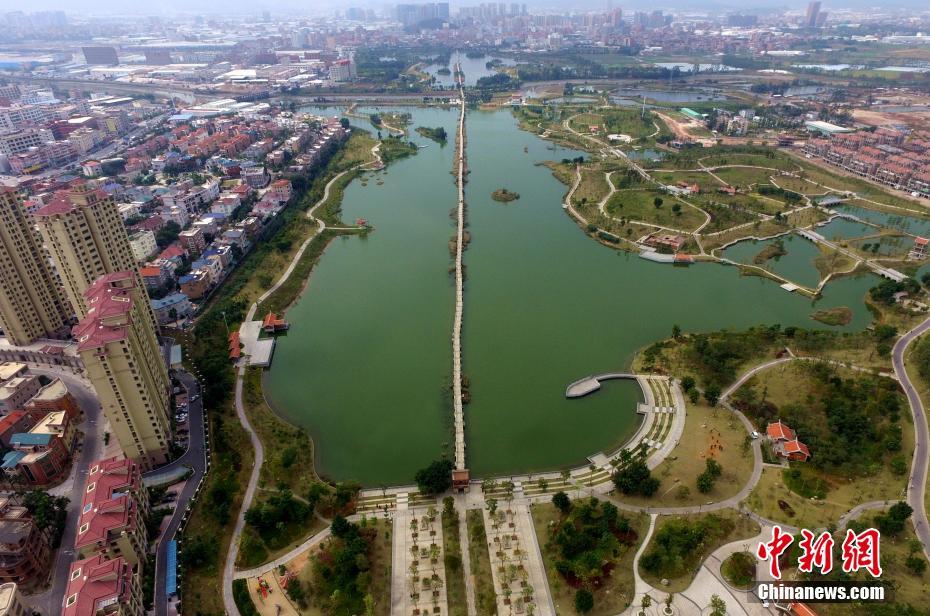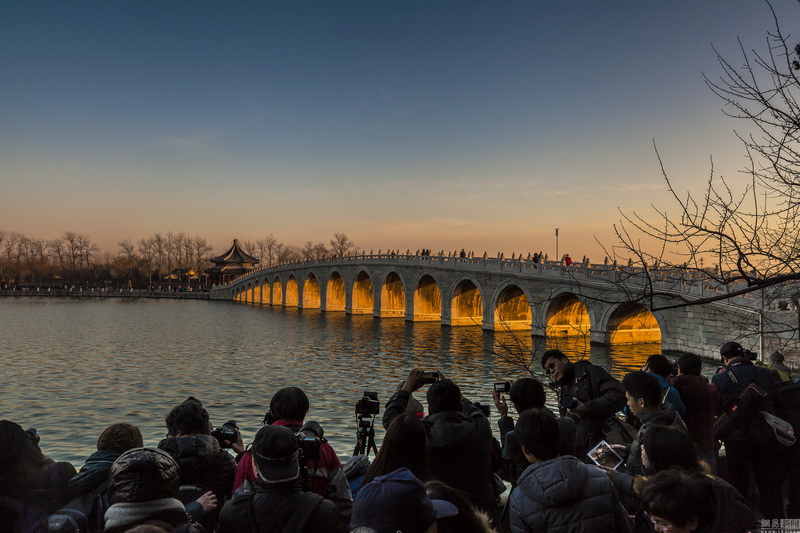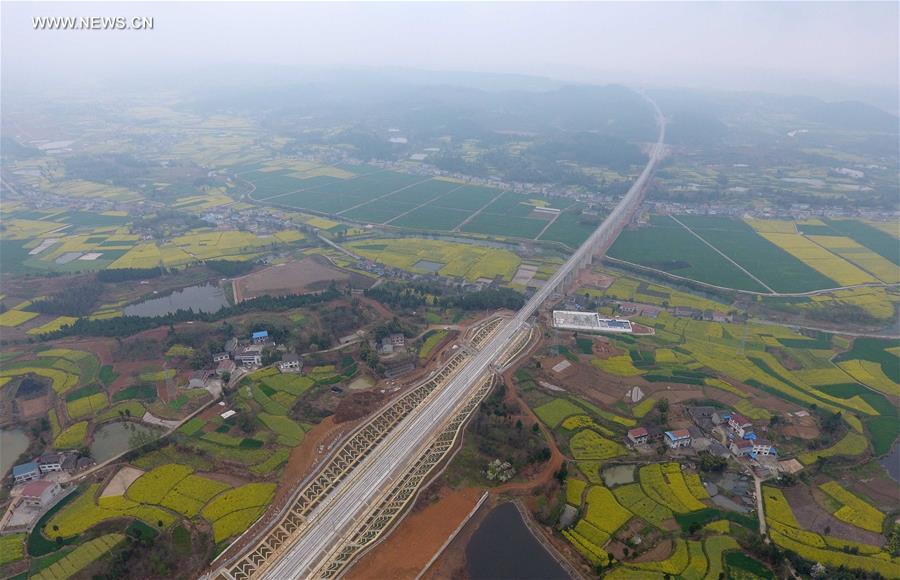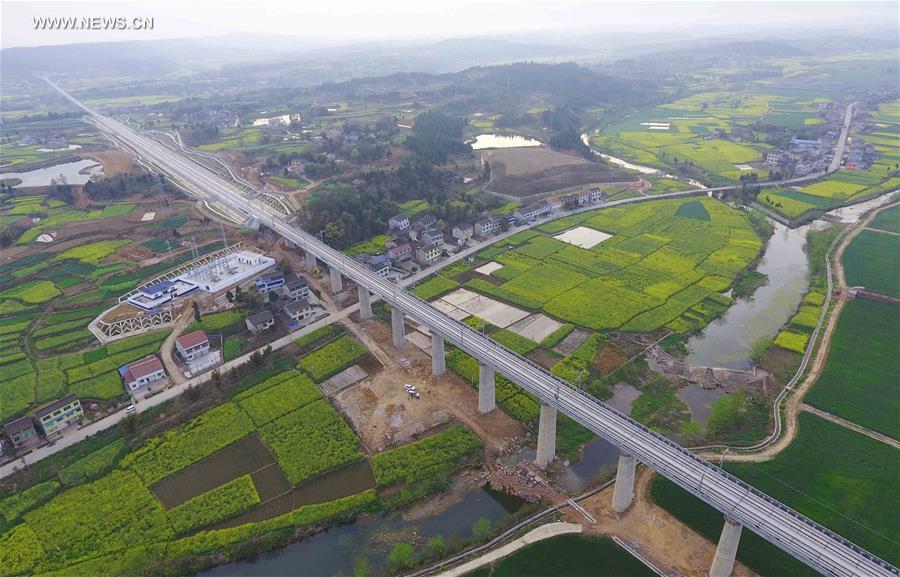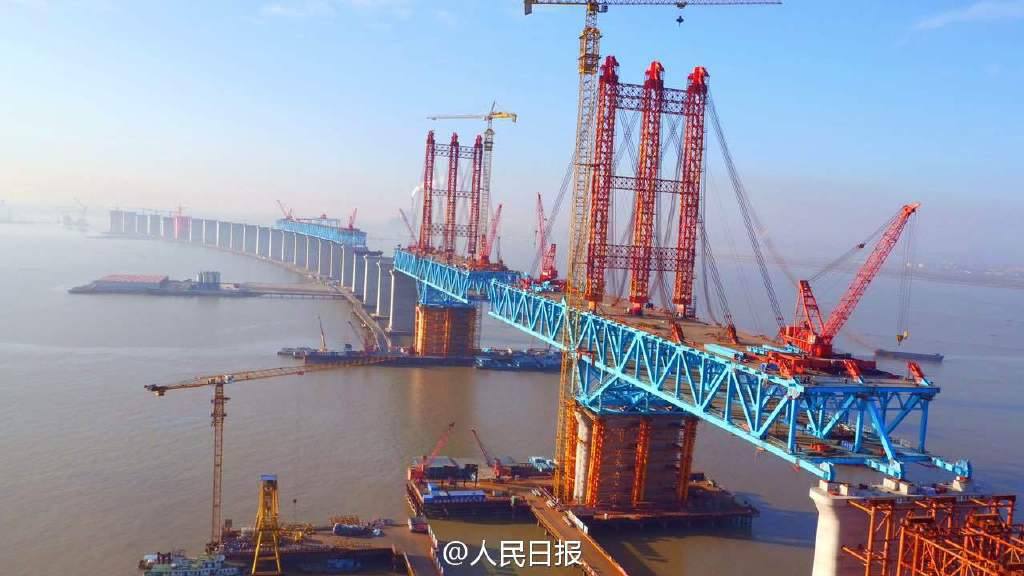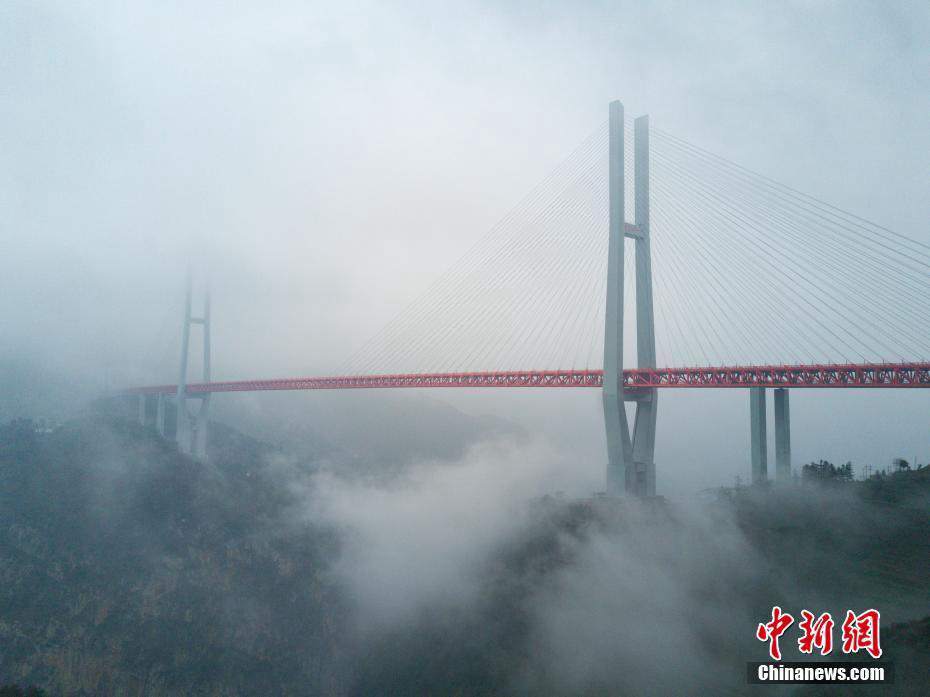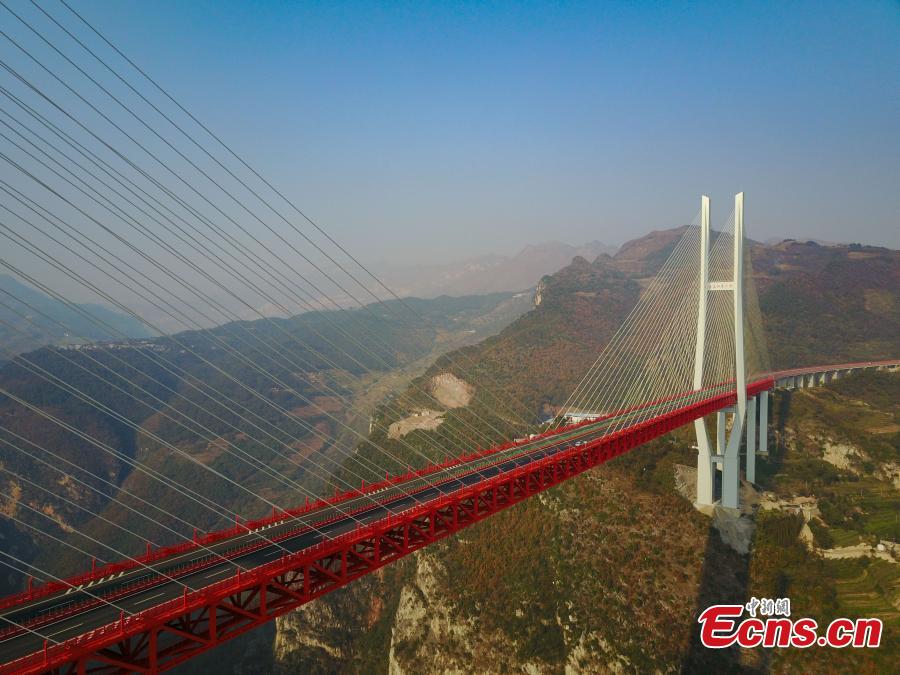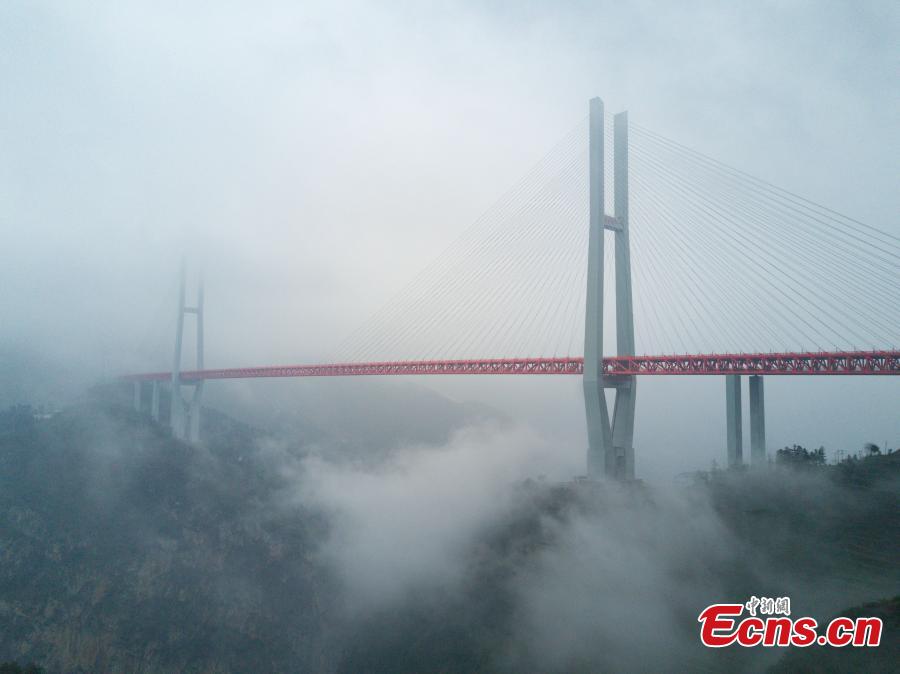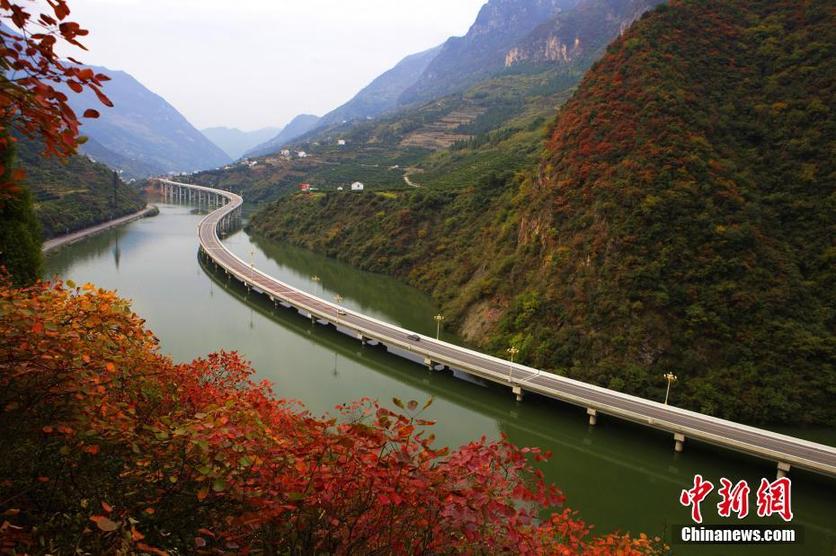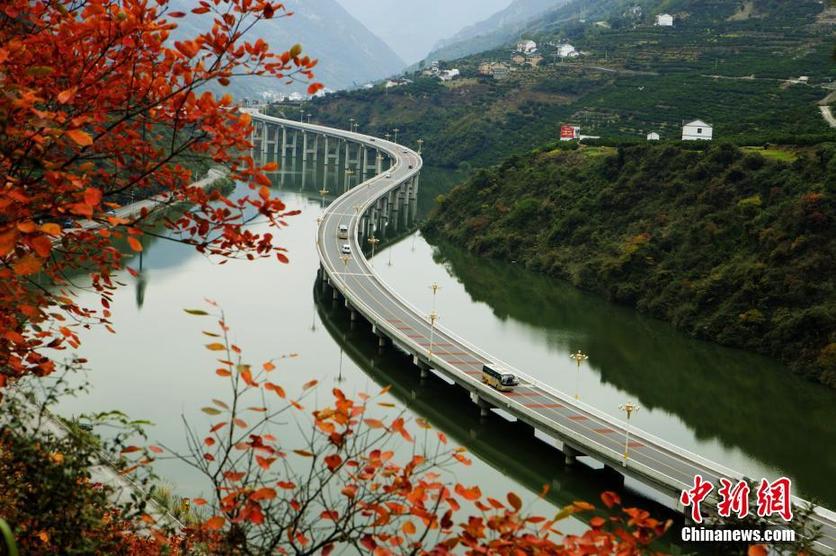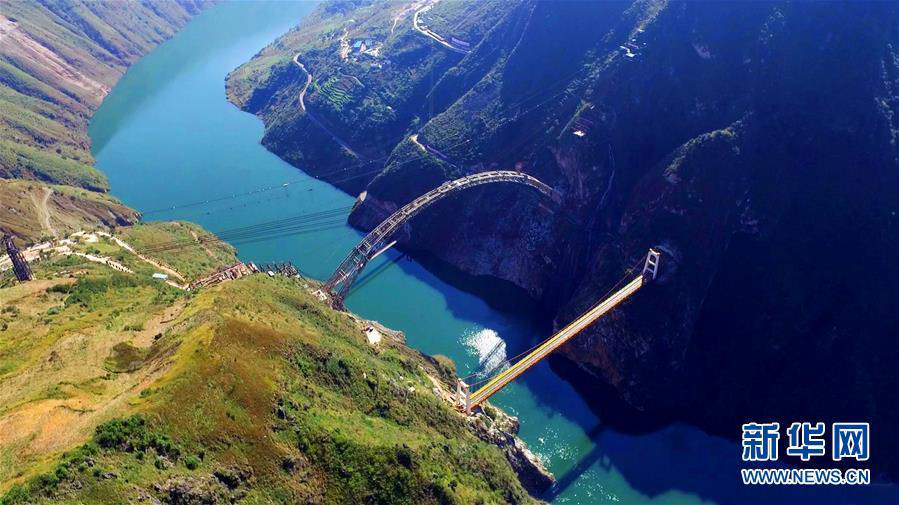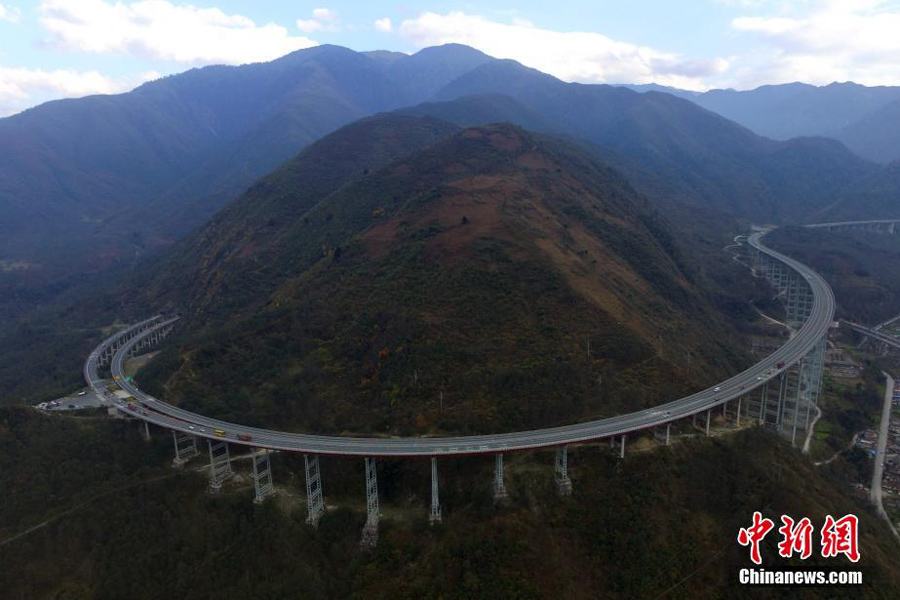Photo taken on April 4, 2017 shows the cloud-wrapped Siduhe Bridge in Enshi, central China's Hubei Province. (Xinhua/Wen Lin)
Photo taken on April 4, 2017 shows the Siduhe Bridge in Enshi, central China's Hubei Province. (Xinhua/Wen Lin)
Photo taken on April 4, 2017 shows the cloud-wrapped Siduhe Bridge in Enshi, central China's Hubei Province. (Xinhua/Wen Lin)
Photo taken on April 4, 2017 shows the cloud-wrapped Siduhe Bridge in Enshi, central China's Hubei Province. (Xinhua/Wen Lin)
(file photo of the NuJiang Railway Bridge)
The world's longest span arch bridge, NuJiang Railway Bridge, in southwest China's Yunnan province has entered the critical stage of main structural assembly on March 9, 2017. It is a project along the Sino-Myanmar Railway.
Located at the junction of the Shidian county and Longling county in southwest China's Yunnan Province, the NuJiang Railway Bridge will have a total length of 1,024 meters. The height of the bridge above the river will be 211 meters. The bridge will mainly use steel truss arch beams with a span of 490 meters.
The construction of the NuJiang Railway Bridge will use over 46,000 tons of steel. It will require rare precision in the manufacturing of the steel trusses, and pose high risks in terms of assembling steel trusses at high-altitude.
The Sino-Myanmar Railway linking China's Kunming and Myanmar's Yangon covers a total length of 1,920 kilometers, among which, a 690-km-long section is in the territory of China. A 350-km-long railway from Kunming to Dali in China has been built. With the Nujiang Railway Bridge, the 340-km-long railway linking Dali and Ruili will help to reducethe current travel time of 7 hours to about 2 hours by train.
Tianxingzhou Bridge is enveloped by heavy fog in Wuhan, capital of central China's Hubei Province, March 7, 2017. (Xinhua)
Tianxingzhou Bridge and surrounding buildings are enveloped by heavy fog in Wuhan, capital of central China's Hubei Province, March 7, 2017. (Xinhua)
A bridge is swung into place to connect with roads on both ends in Shijiazhuang City, the capital of North China’s Hebei Province, March 2, 2017. The bridge is 242.6 meters long and has six lanes in both directions. The structure was built separately and then rotated into place on an axis. It’s said to be the longest bridge ever swung into place on a single axis in the world. (Photo: China News Service/Zhai Yujia)
A bridge from the Ming Dynasty (1368-1644) reemerges from Xiannu (fairy) Lake after water levels drop in Xinyu City, East China's Jiangxi Province, March 1, 2017. The original stone arch bridge measured 384 meters long and 7.68 meters wide, with 11 arches. The bridge was submerged after a dam was built in 1958, but during the dry season, it reemerges from the water. (Photo: China News Service/Wang Jian)
A view of a renovated ancient stone bridge in the Poyang Lake in Duchang County, East China’s Jiangxi Province. The ancient bridge constructed during the Ming Dynasty (1368-1644) was once a popular thoroughfare for people living by China's largest freshwater lake. Made from granite, measuring more than 2,900 meters, the structure was known as 'thousand-eye bridge' because it had about 1,000 holes. Now it only appears after water dries up. The bridge has finished its first major renovation soon. (Photo: China News Service/Fu Jianbin)
Four sculptures are newly visible beneath the ancient site of Seven Bridge Urn in Nanjing, Jiangsu province, China.com.cn reported.
The Seven Bridge Urn was built during the Ming Dynasty (1368-1644). It is 89.6 meters long and 25 meters high. The stone beasts under its arches were designed to divert water and reduce the impact of the current on the bridge. They also draw attention to the channels, serving as a reminder to sailboats to avoid knocking into the stone structure, explained Hu Zhuoran, a Nanjing-based historian.
Photo taken on Dec. 21 shows a bird's-eye view of Anping Bridge, China's longest ancient stone bridge, in Jinjiang, Fujian province. (Chinanews.com/Wang Dongming)
Anping Bridge is located in the town of Anhai in Fujian province's Jinjiang County. The bridge spans the bay between Jinjiang and Nan’an.
Beginning from the eighth year of the reign of Shaoxing (1138) of the Southern Song dynasty (1127-1279), construction of the bridge lasted 14 years. The length of the bridge is approximately 5 li (1 li is equal to 500 meters), so it is sometimes called Wuli Bridge (Five-li Bridge). It was the longest stone-beam bridge in the world during the Middle Ages. The bridge is now a national protected historic site.
Photo taken on Dec. 21 shows a bird's-eye view of Anping Bridge, China's longest ancient stone bridge, in Jinjiang, Fujian province. (Chinanews.com/Wang Dongming)
Photo taken on Dec. 21 shows a bird's-eye view of Anping Bridge, China's longest ancient stone bridge, in Jinjiang, Fujian province. (Chinanews.com/Wang Dongming)
Spectacular view of the Seventeen-arch Bridge in the Summer Palace on Dec. 28, 2016. Due to careful calculations regarding the angle of the bridge, it's possible to glimpse a striking sight near the Winter Solstice. At that time, all 17 of the bridge's arches are illuminated by the sunset, flooded by a warm golden light.
This aerial photo taken on March 29, 2017 shows the newly-built Qinggangba bridge of the railway line for passenger transport in southwest China's Sichuan Province. The 250-km-per-hour inter-city passenger line will link Xi'an, capital of northwest China's Shaanxi Province, with Sichuan's capital Chengdu. As the construction is nearly to be completed, it will become the country's first high-speed railway passing through the Qinling Mountains. (Xinhua/Xue Yubin)
This aerial photo taken on March 29, 2017 shows the newly-built Qinggangba bridge of the railway line for passenger transport in southwest China's Sichuan Province. The 250-km-per-hour inter-city passenger line will link Xi'an, capital of northwest China's Shaanxi Province, with Sichuan's capital Chengdu. As the construction is nearly to be completed, it will become the country's first high-speed railway passing through the Qinling Mountains. (Xinhua/Xue Yubin)
World's longest heavy-duty steel arch bridge, part of the 11k meter long Hutong (Shanghai-Nantong) Yangtze River Bridge in E China, was connected on Sat. (Peopkle's Daily Online)
Beipanjiang Bridge, the world’s highest bridge, was officially opened to traffic on Dec. 28. Jointly built by Guizhou and Yunnan provinces, the bridge is a project of Bijie-Doge section of the Hangzhou-Ruili Expressway. Lying 565 meters above the river, the structure appears like a thin piece of paper seen from the sky.
An aerial view of the Beipanjiang Bridge connecting Guizhou and Yunnan provinces, Dec. 28, 2016. As the world’s highest bridge, it soars 565m above a river and opens to the public on Thursday. The bridge cut road trips from Liupanshui in Guizhou to Xuanwei in Yunnan from over four hours to less than two. (Photo: China News Service/He Junyi)
An aerial view of the Beipanjiang Bridge connecting Guizhou and Yunnan provinces, Dec. 28, 2016. As the world’s highest bridge, it soars 565m above a river and opens to the public on Thursday. The bridge cut road trips from Liupanshui in Guizhou to Xuanwei in Yunnan from over four hours to less than two. (Photo: China News Service/He Junyi)
China’s first over-water highway skims across a river in Xingshan, Hubei province, bypassing nearby mountains in order to avoid cutting down lush forests. Like a silk ribbon floating on the shimmering water, this unusual bridge is a love letter to nature. It has boosted local tourism due to its picturesque scenery and magnificent design. (Chinanews.cn)
China’s first over-water highway skims across a river in Xingshan, Hubei province, bypassing nearby mountains in order to avoid cutting down lush forests. Like a silk ribbon floating on the shimmering water, this unusual bridge is a love letter to nature. It has boosted local tourism due to its picturesque scenery and magnificent design. (Chinanews.cn)
China’s first over-water highway skims across a river in Xingshan, Hubei province, bypassing nearby mountains in order to avoid cutting down lush forests. Like a silk ribbon floating on the shimmering water, this unusual bridge is a love letter to nature. It has boosted local tourism due to its picturesque scenery and magnificent design. (Chinanews.cn)
China’s first over-water highway skims across a river in Xingshan, Hubei province, bypassing nearby mountains in order to avoid cutting down lush forests. Like a silk ribbon floating on the shimmering water, this unusual bridge is a love letter to nature. It has boosted local tourism due to its picturesque scenery and magnificent design. (Chinanews.cn)
A steel-tube arch bridge in Yunnan province was successfully closed on Nov. 15. The main body of the 528-meter bridge, which stretches across Lancang River, has a span of 342 meters. (Photo / Xinhua)
Photo taken on November 12, 2016 shows the Ganhaizi Bridge, the world's longest concrete tubular bridge. Built to stand 2,500 meters above sea level, the bridge is 1,811 meters long, 24.5 meters wide and has 36 bridge spans. The huge "roller coaster" boasts the world's highest steel pipe concrete lattice pier, composite pier and hybrid bridge pier. It is the first bridge to use steel fiber concrete as structural material. It makes an important part of China's first high speed "double helix tunnel" through the mountainous Yaxi expressway of Ya'an City, southwest China's Sichuan Province. [Photo: Chinanews.com]
A bridge in Chongqing has become an Internet sensation due to its bizarre architectural style. The 400-meter bridge is crammed with both traditional Chinese elements and Western-style features. Together, the hybrid characteristics have created an unusual experience for visitors. (Photo / Chinanews.cn)
A bridge in Chongqing has become an Internet sensation due to its bizarre architectural style. The 400-meter bridge is crammed with both traditional Chinese elements and Western-style features. Together, the hybrid characteristics have created an unusual experience for visitors. (Photo / Chinanews.cn)
Cars run on the Nanjing Yangtze River Bridge in Nanjing, capital of east China's Jiangsu Province, Oct. 21, 2016. The Nanjing Yangtze River Bridge will be closed for repair for 27 months from Oct. 28. (Xinhua/Wang Xin)
Photo taken on Oct. 8, 2016 shows the Nanjing Yangtze River Bridge in Nanjing, capital of east China's Jiangsu Province. The Nanjing Yangtze River Bridge will be closed for repair for 27 months from Oct. 28. (Xinhua/Su Yang)
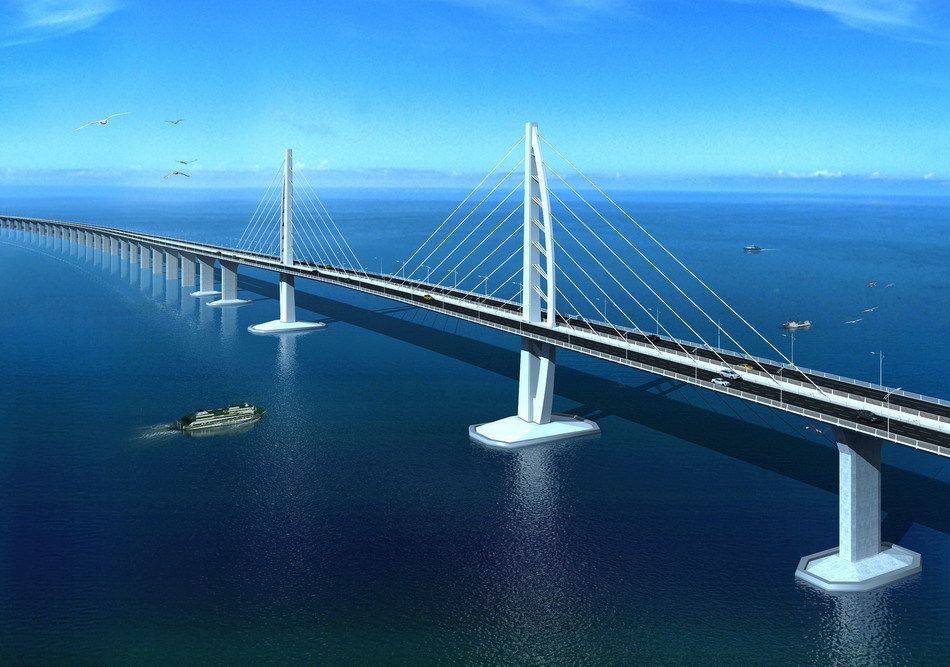
Drawing of the Hong Kong-Zhuhai-Macau Bridge (Photo/Xinhua)
Hong Kong-Zhuhai-Macau Bridge
The assembly of the first curved section of the underwater tunnel for the Hong Kong-Zhuhai-Macau Bridge was successfully completed on Oct. 8, 2016. Hailed by The Guardian as "one of the seven modern wonders in the world," it is the world's longest bridge currently under construction.
Starting from Lantau Island in Hong Kong, the Y-shaped bridge will boast a total length of about 55 kilometers, including a 6.7-kilometer underwater tunnel and a 23-kilometer bridge over the sea. Artificial islands will be built at both ends of the tunnel to allow for the passage of large ships.
The bridge will serve as an important channel linking Hong Kong, Macau, Zhuhai and the western part of the Pearl River Delta, one of the most economically developed areas in the Chinese mainland.
Construction of the bridge started in 2009. Its total cost will come to some 10 billion RMB ($1.5 billion). It is expected to be completed by the end of 2017. Once in operation, the commute time between Hong Kong and Zhuhai or Macau will be reduced from three and a half hours to just 30 minutes.

















